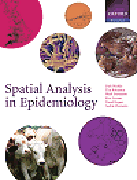
Spatial analysis in epidemiology
Pfeiffer, Dirk U.
Robinson, Tim
Stevenson, Mark
Stevens, Kim B.
Only introductory level text available, bringing together a specialised and widely-dispersed literature Examines the use of GIS and remotely sensed data to understand and predict disease prevalence Includes a wide range of examplestaken from both medical and veterinary disciplines, and including both infectious diseases and non-infectious conditions Provides worked examples using a single data set, following standardised nomenclature throughout Structured tofollow the logical sequence of description of spatial data, visualisation, exploration, modelling and decision supportThis book provides a practical, comprehensive and up-to-date overview of the use of spatial statistics in epidemiology - the study of the incidence and distribution of diseases. Used appropriately, spatial analytical methods in conjunction with GIS and remotely sensed data can provide significant insights intothe biological patterns and processes that underlie disease transmission. In turn, these can be used to understand and predict disease prevalence. This user-friendly text brings together the specialised and widely-dispersed literature on spatial analysis to make these methodological tools accessible to epidemiologists for the first time. With its focus is on application rather than theory, Spatial Analysis in Epidemiology includes a wide range of examples taken from both medical (human) and veterinary (animal) disciplines, and describes both infectious diseases and non-infectious conditions. Furthermore, it provides worked examples of methodologies using a single data set from the same disease example throughout, and is structured to follow the logical sequence of description of spatial data, visualisation, exploration, modelling and decision support. This accessible text is aimed at graduate students and researchers dealing with spatial data in the fields of epidemiology (both medical and veterinary), ecology, zoology and parasitology, environmental science, geography and statistics. INDICE: Abbreviations Preface 1. Introduction 2. Spatial data 3. Spatial visualisation 4. Spatial clustering of disease and global estimates of cluster analysis 5. Local estimates of spatial clustering 6. Spatial variationin risk 7. Identifying factors associated with the spatial distribution of disease 8. Spatial assessment and management of disease risk
- ISBN: 978-0-19-850989-9
- Editorial: Oxford University
- Encuadernacion: Rústica
- Páginas: 142
- Fecha Publicación: 01/01/2008
- Nº Volúmenes: 1
- Idioma: Inglés
